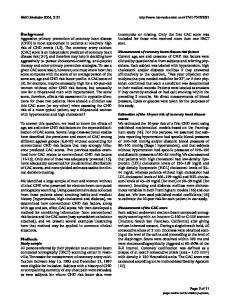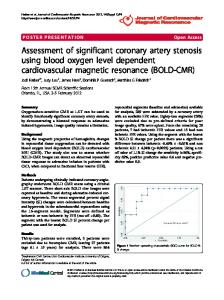Fully automated derivation of coronary artery calcium scores and cardiovascular risk assessment from contrast medium-enh
- PDF / 270,752 Bytes
- 8 Pages / 595.276 x 790.866 pts Page_size
- 9 Downloads / 364 Views
CARDIAC
Fully automated derivation of coronary artery calcium scores and cardiovascular risk assessment from contrast medium-enhanced coronary CT angiography studies Ullrich Ebersberger & Dov Eilot & Roman Goldenberg & Alon Lev & J. Reid Spears & Garrett W. Rowe & Nicholas Y. Gallagher & William T. Halligan & Philipp Blanke & Marcus R. Makowski & Aleksander W. Krazinski & Justin R. Silverman & Fabian Bamberg & Alexander W. Leber & Ellen Hoffmann & U. Joseph Schoepf
Received: 2 July 2012 / Revised: 13 August 2012 / Accepted: 19 August 2012 / Published online: 16 September 2012 # European Society of Radiology 2012
Abstract Objectives Performance evaluation of a fully automated system for calculating computed tomography (CT) coronary artery calcium scores from contrast medium-enhanced coronary CT angiography (cCTA) studies. Methods One hundred and twenty-seven patients (58 ± 11 years, 71 men) who had undergone cCTA as well as an unenhanced CT calcium scoring study where included. Calcium scores were computed from cCTA by an automated image processing algorithm and compared with calcium scores obtained by standard manual assessment of unenhanced CT calcium scoring studies. Results were compared vis-a-vis (1) absolute calcium score values, (2) age-, genderU. Ebersberger : J. R. Spears : G. W. Rowe : N. Y. Gallagher : W. T. Halligan : P. Blanke : A. W. Krazinski : J. R. Silverman : U. J. Schoepf (*) Department of Radiology and Radiological Science, Medical University of South Carolina, Ashley River Tower, 25 Courtenay Drive, Charleston, SC 29425-2260, USA e-mail: [email protected] U. Ebersberger : E. Hoffmann Department of Cardiology and Intensive Care Medicine, Heart Centre Munich-Bogenhausen, Munich, Germany D. Eilot : R. Goldenberg : A. Lev Rcadia Medical Imaging Ltd, Haifa, Israel
and race-dependent percentiles, and (3) commonly used calcium score risk classification categories. Results One hundred and nineteen out of 127 (93.7%) studies were successfully processed. Mean Agatston calcium score values obtained by traditional non-contrast CT calcium scoring studies and derived from contrast medium-enhanced cCTA did not significantly differ (235.6±430.5 vs 262.0±499.5; P> 0.05). Calcium score risk categories and Multi-Ethnic Study of Atherosclerosis (MESA) percentiles showed very high correlation (Spearman rank correlation coefficient00.97, P< 0.0001/0.95, P25 kg/m2, whereas the tube potential was reduced to 100 kV in patients with a BMI 5 years of experience in cardiac CT performed coronary artery calcium quantification on each unenhanced CT calcium scoring study using commercially available software (Calcium Scoring module of Aquarius iNtuition; TeraRecon, San Mateo, CA, USA), which automatically accounts for various kV settings when determining the calcium score. Routine, clinical parameters and settings according to the Agatston method were employed with a detection threshold of 130 HU [13]. The global calcium score, cardiovascular risk categories based on discrete calcium score brackets [14], and age/gender/race-d
Data Loading...











